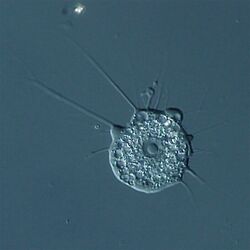Biology:Holomycota
| Holomycota | |
|---|---|

| |
| Nuclearia | |
| Scientific classification | |
| Domain: | Eukaryota |
| Clade: | Amorphea |
| Clade: | Obazoa |
| (unranked): | Opisthokonta |
| Clade: | Holomycota Liu et al., 2009 |
| Groups[1] | |
| |
| Synonyms | |
| |
Holomycota or Nucletmycea are a basal Opisthokont clade as sister of the Holozoa. It consists of the Cristidiscoidea and the kingdom Fungi. The position of nucleariids, unicellular free-living phagotrophic amoebae,[3] as the earliest lineage of Holomycota suggests that animals and fungi independently acquired complex multicellularity from a common unicellular ancestor and that the osmotrophic lifestyle (one of the fungal hallmarks) was originated later in the divergence of this eukaryotic lineage. Opisthosporidians is a recently proposed taxonomic group that includes aphelids,[4] Microsporidia and Cryptomycota, three groups of endoparasites.[5]
Rozella (Cryptomycota) is the earliest diverging fungal genus in which chitin has been observed at least in some stages of their life cycle,[5] although the chitinous cell wall (another fungal hallmark) and osmotrophy originated in a common ancestor of Blastocladiomycota and Chytridiomycota, which still contain some ancestral characteristics such as the flagellum in zoosporic stage.[6] The groups of fungi with the characteristic hyphal growth, Zoopagomycota, Mucoromycotina and Dikarya, originated from a common ancestor ~700 Mya.[6] Zoopagomycota are mostly pathogens of animals or other fungi, Mucoromycotina is a more diverse group including parasites, saprotrophs or ectomycorrhizal.[5] Dikarya is the group embracing Ascomycota and Basidiomycota, which comprise ~98% of the described fungal species.[6] Because of this rich diversity, Dikarya includes highly morphologically distinct groups, from hyphae or unicellular yeasts (such as the model organism Saccharomyces cerevisiae) to the complex multicellular fungi popularly known as mushrooms.[6] Contrary to animals and land plants with complex multicellularity, the inferred phylogenetic relationships indicate that fungi acquired and lost multicellularity multiple times along Ascomycota and Basidiomycota evolution.[7]
Phylogeny
The phylogenetic tree depicts the fungi and their close relationship to other organisms, based on the work of Philippe Silar[8] and "The Mycota: A Comprehensive Treatise on Fungi as Experimental Systems for Basic and Applied Research".[9][10] The holomycota tree is following Tedersoo et al.[11][12][13]
| Opisthokonts |
| ||||||||||||||||||||||||||||||||||||||||||||||||||||||||||||||||||||||||||||||||||||||||||
References
- ↑ Adl, Sina M.; Simpson, Alastair G. B.; Lane, Christopher E.; Lukeš, Julius; Bass, David; Bowser, Samuel S.; Brown, Matthew W.; Burki, Fabien et al. (2012). "The Revised Classification of Eukaryotes". Journal of Eukaryotic Microbiology 59 (5): 429–514. doi:10.1111/j.1550-7408.2012.00644.x. PMID 23020233.
- ↑ "Phylogeny of the "forgotten" cellular slime mold, Fonticula alba, reveals a key evolutionary branch within Opisthokonta". Mol. Biol. Evol. 26 (12): 2699–709. December 2009. doi:10.1093/molbev/msp185. PMID 19692665.
- ↑ López‐Escardó, David; López‐García, Purificación; Moreira, David; Ruiz‐Trillo, Iñaki; Torruella, Guifré (2017-08-12). "Parvularia atlantis gen. et sp. nov., a Nucleariid Filose Amoeba (Holomycota, Opisthokonta)". Journal of Eukaryotic Microbiology 65 (2): 170–179. doi:10.1111/jeu.12450. ISSN 1550-7408. PMID 28741861.
- ↑ Karpov, Sergey; Mamkaeva, Maria A.; Aleoshin, Vladimir; Nassonova, Elena; Lilje, Osu; Gleason, Frank H. (2014). "Morphology, phylogeny, and ecology of the aphelids (Aphelidea, Opisthokonta) and proposal for the new superphylum Opisthosporidia". Frontiers in Microbiology 5: 112. doi:10.3389/fmicb.2014.00112. PMID 24734027.
- ↑ 5.0 5.1 5.2 Berbee, Mary L.; James, Timothy Y.; Strullu-Derrien, Christine (2017-09-08). "Early Diverging Fungi: Diversity and Impact at the Dawn of Terrestrial Life". Annual Review of Microbiology 71 (1): 41–60. doi:10.1146/annurev-micro-030117-020324. PMID 28525299.
- ↑ 6.0 6.1 6.2 6.3 Stajich, Jason E.; Berbee, Mary L.; Blackwell, Meredith; Hibbett, David S.; James, Timothy Y.; Spatafora, Joseph W.; Taylor, John W. (2009-09-29). "The Fungi". Current Biology 19 (18): R840–R845. doi:10.1016/j.cub.2009.07.004. PMID 19788875.
- ↑ Nguyen, Tu Anh; Cissé, Ousmane H.; Wong, Jie Yun; Zheng, Peng; Hewitt, David; Nowrousian, Minou; Stajich, Jason E.; Jedd, Gregory (2017-02-08). "Innovation and constraint leading to complex multicellularity in the Ascomycota". Nature Communications 8: ncomms14444. doi:10.1038/ncomms14444. PMID 28176784. Bibcode: 2017NatCo...814444N.
- ↑ Protistes Eucaryotes: Origine, Evolution et Biologie des Microbes Eucaryotes. HAL. 2016. p. 462. ISBN 978-2-9555841-0-1. https://hal.archives-ouvertes.fr/hal-01263138/document.
- ↑ The Mycota VII A: Systematics and Evolution (2nd ed.). Springer. 2014. p. 461. ISBN 978-3-642-55317-2. http://www.nhbs.com/title/199258/the-mycota-volume-7a-systematics-and-evolution.
- ↑ Bass, David; Czech, Lucas; Williams, Bryony A. P.; Berney, Cédric; Dunthorn, Micah; Mahé, Frederic; Torruella, Guifré; Stentiford, Grant D. et al. (2018-04-28). "Clarifying the Relationships between Microsporidia and Cryptomycota" (in en). Journal of Eukaryotic Microbiology 65 (6): 773–782. doi:10.1111/jeu.12519. ISSN 1066-5234. PMID 29603494.
- ↑ Tedersoo, Leho; Sánchez-Ramírez, Santiago; Kõljalg, Urmas; Bahram, Mohammad; Döring, Markus; Schigel, Dmitry; May, Tom; Ryberg, Martin et al. (2018). "High-level classification of the Fungi and a tool for evolutionary ecological analyses" (in en). Fungal Diversity 90 (1): 135–159. doi:10.1007/s13225-018-0401-0. ISSN 1560-2745.
- ↑ Lopez-Garcia, Purificacion; Volcker, Eckhard; Sebe-Pedros, Arnau; Burns, John; Karpov, Sergey A.; Moreira, David; Grau-Bove, Xavier; Torruella, Guifre (2018-08-17). "The aphelid-like phagotrophic origins of fungi" (in en). bioRxiv: 233882. doi:10.1101/233882. https://www.biorxiv.org/content/10.1101/233882v3.
- ↑ Galindo, Luis Javier; Torruella, Guifré; López-García, Purificación; Ciobanu, Maria; Gutiérrez-Preciado, Ana; Karpov, Sergey A; Moreira, David (2022-07-28). "Phylogenomics Supports the Monophyly of Aphelids and Fungi and Identifies New Molecular Synapomorphies". Systematic Biology. https://doi.org/10.1093/sysbio/syac054.
Wikidata ☰ Q2943473 entry
 |



